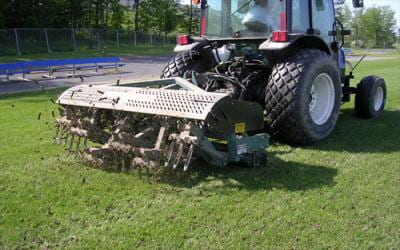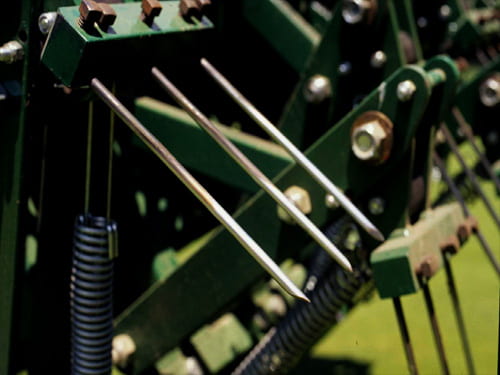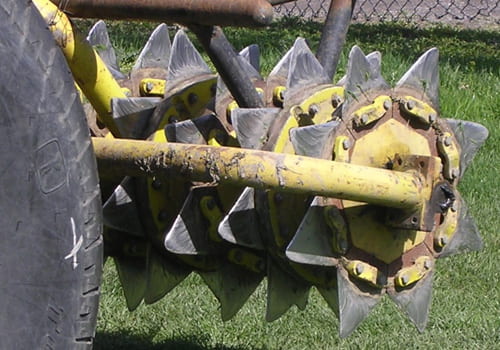Why are fields routinely cultivated?

Cultivation methods, including coring, slicing, spiking, drilling, vertical mowing and injecting water, are used to remediate compacted soils, aid in overseeding and help manage thatch. Foot traffic and vehicular traffic cause soil compaction, especially on fine-textured (clayey) soils which results in surface puddling and runoff. Compaction reduces access to water, nutrients and oxygen necessary for plant growth. Compaction also makes it difficult for added amendments like lime and fertilizer to reach the root zone.
Strategies to reduce soil compaction and improve better surface drainage and gaseous exchange for enhanced root growth include:
- Limiting vehicular traffic or using special turf tires when on fields that are prone to compaction.
- Avoiding field use when soils are saturated.
- Avoiding irrigation 24 to 48 hours before a game or major event.
- Limiting the number of games and events on your fields, especially fields that are prone to compaction.
- Setting aside one field that will serve as your game or showcase field and not allowing practice on it.
Always make multiple passes to impact larger surface area. Do not aerify or cultivate the soil when the turf is under stress or when the soil is too wet (which would destroy soil structure) or when the soil is too dry (which would make pulling cores difficult and could harm turf roots). Usually one to two days after a normal rainfall on a moderately well-drained soil would be good timing for this practice.
Cultivation methods
Coring in the early fall can increase the opportunity for annual bluegrass (Poa annua), invasion. However, a Penn State study found that there was less Poa invasion when solid tines were used versus hollow tines, so use solid times at this time.
Coring, slicing, spiking, drilling, vertical mowing and injecting water into the soil are methods used to deal with soil compaction.
Core cultivation (often referred as aerification) removes a core of soil, leaving a small hole which allows for better water and air movement into the root zone. Fertilizer and amendments can more easily reach the root zone resulting in a deeper more extensive root system.
Coring with hollow tines or spoons removes a soil core which can be collected or left on the soil surface. Tines can be placed in various spacings and can range ¼”- ¾” in diameter and penetrate the soil 3-6″. Keep in mind that the size and spacing of tines influences the area of impact. For example: ½” tines spaced on 2” centers will impact only 5% of the surface whereas 5/8” tines spaced on 1”x 2” centers will impact 15% of the surface. Ideally, each coring should impact at least 10% of the turf surface which is about 10 to 15 holes per square foot.
Soil cores left on the soil surface should be allowed to dry and then dragged with a mat to break them up. This process mixes soil into the thatch layer where microorganisms can begin to decompose the thatch. This would be a good time to apply lime or fertilizer if needed.

Spiking uses solid tines to punch holes into the soil when less soil surface disruption is desired. This action actually causes compaction at the bottom and sides of the hole and is not as effective as hollow tine coring in improving soil physical properties. However, it is effective on heavily compacted areas especially when improving soil aeration is desired. Shatter tines are used to fracture hardpans in the subsoil.
Slicing cuts a narrow slit into the soil and encourages lateral growth of Kentucky bluegrass. Slicing equipment can also be used when overseeding to provide a place for seed to germinate.

Deep drilling can create channels to a 12″ depth with metal bits up to 1″ in diameter. This kind of cultivation is often used to improve subsurface drainage on highly compacted areas of football and soccer fields. Fields may benefit from deep tine aerification once or twice a year if the drill goes deep enough to go below the depth of compaction.
Vertical mowing uses blades that cut vertically into the turf canopy to sever lateral stems. This practice helps to increase turf density, remove thatch at the soil surface and prepare the turf for overseeding.
Injecting high pressured water into the soil through small-diameter nozzles opens channels for roots to grow with limited disruption of the surface.
Select the best cultivation method that matches your goal. Some methods should be used when fields are not in use while others can be used during the playing season.
Cultivation practices for use between playing seasons
Adapted from Dave Minner, Iowa State University| Match cultivation goal (below) with the tool (right) | Hollow tine 4-inch |
Solid tine 4-inch |
Hydro- jet |
Shatter tine 4-inch |
Shatter blade |
Verti- drain |
Drill & fill |
Slicing | Small slicing/ spiking |
Vertical mower |
|---|---|---|---|---|---|---|---|---|---|---|
| Change soil type in top 4 inches by removing soil and back filling with amendment |
X | X | ||||||||
| Create large and deep holes or channels that can be back filled with a soil amendment |
X | |||||||||
| Remove surface soil layer that was attached to sand-sod during sand-based field construction |
X | X | ||||||||
| Promote deep rooting, 8 inches or more |
X | X | X | X | X | |||||
| Maximum removal of water puddles |
X | X | X | |||||||
| Aggressive fracturing of hard ground (surface to 6 inches deep) |
X | X | X |
Cultivation practices for use during playing seasons
Adapted from Dave Minner, Iowa State University| Match cultivation goal (below) with the tool (right) | Hollow tine 4-inch |
Solid tine 4-inch |
Hydro- jet |
Shatter tine 4-inch |
Shatter blade |
Verti- drain |
Drill & fill |
Slicing | Small slicing/ spiking |
Vertical mower |
|---|---|---|---|---|---|---|---|---|---|---|
| Increase initial water infiltration rate with minimal disturbance to surface |
X | X | X | X | X | X | X | |||
| Plant seed with minimal disturbance to grass and soil stability |
X | X | ||||||||
| Encourage lateral growth of sod forming grasses |
X | X | ||||||||
| Fracture hard skin infield, drag surface and begin play |
X | |||||||||
| Fracture hard grass fields | X | X | X | |||||||
| Fast operation over field | X |
What about frequency and timing?
The benefits of cultivation are short-lived and therefore should be done frequently. High traffic areas should be cultivated 6-8 times per year. A suggested coring schedule could entail heavy coring in the spring prior to fertilization, light coring in late summer and early fall before fertilization and heavy coring at the end of the season. At that time you can collect the cores and let the holes remain open for freezing and thawing action.


